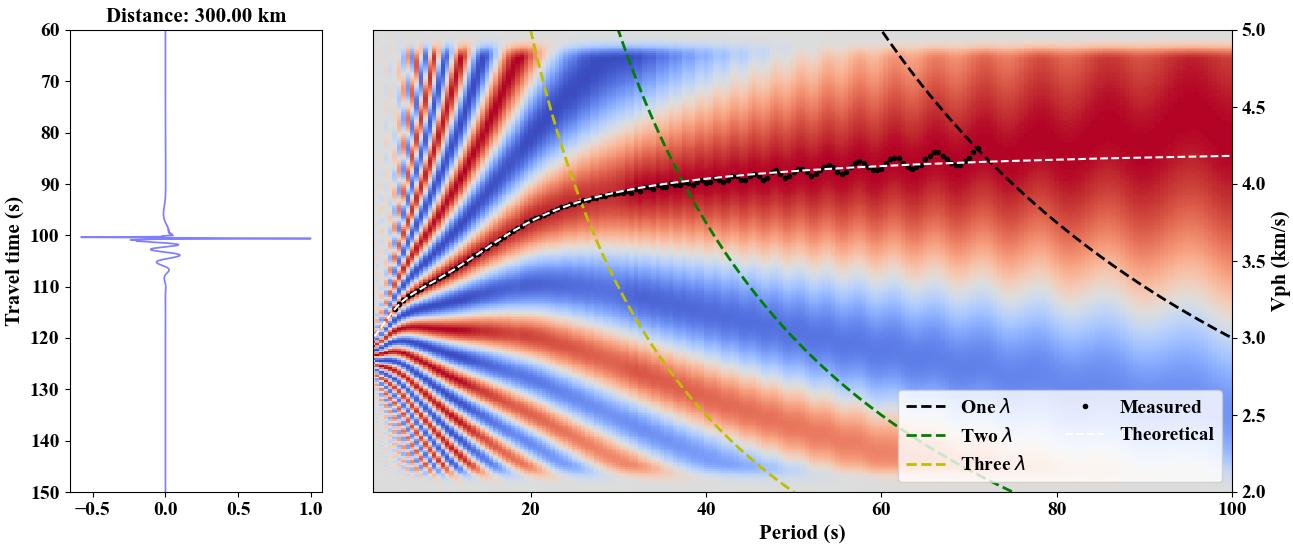Image transform technique for estimating phase velocity dispersion curve
Contents
Background
Ambient noise tomography is widely used to image th earth’s interior in past over two decades for various scales. Stacked cross-correlations from seismic ambient noise can be approxmately the Green’s functions between receivers. Surface waves extracted from ambient noise cross-correlations are frequently utilized to estimate multi-layered shear wave velocity structure. The key to surface wave imageing is reliable dispersion curves. Two-staion techniques, like frequency-time analysis (Levshin et al., 1989), image transform (Yao et al., 206) and zero-crossing (Ekstrom et al., 2009), are popular methods of extracting dispersion curves. Here we introduce the image transform technique for estimating surface wave phase velocity dispersion curves.
Basic principles
In order to satisfy the far-field approximation, we require the epicentral distance $\Delta$ to be three times of the largest wavelength of considered harmonic signals. The phase traveltime $t$ from source A to receiver B holds $$ k_{AB} - \omega t + \frac{\pi}{4}=0, \tag{1} $$ where, $k_{AB}$ and $\omega$ are wavenumber and angular frequency of signal traveling from A to B. Using relation $\omega=2\pi/T$ and $k_{AB}=2\pi/T/c_{AB}$The average phase velocity $c_{AB}$ between A and B is given by $$ c_{AB} = \frac{\Delta}{t-T/8}, \tag{2} $$ in which, $T$ is the period.
Numerical examples
We use the CPS package (https://www.eas.slu.edu/eqc/eqc_cps/getzip.html) to compute vertical and radial component Green’s functions
to check the reliability of estimating dispersion curve using the image transform technique. Suppose that the shell script file name
is run_syn_sac.sh containing the following shell codes:
|
|
Note that you should prepare a model file model.md for doing synthetics:
|
|
Run the script kile sh run_syn_sac.sh 300 1 1 0 to obtain veritcal and radial component Green’s functions with
epicentral distance of 300 km: B00101Z00.sac, B00102R00.sac. Note that there is a file named SREGN.TXT of
storing the synthetic Rayleigh wave dispersion data.
Now we implement the python codes of estimating dispersion curve from radial component Green’s function utilizing the image transform technique.
|
|
 One should note that there are 2$\pi$ ambiguities in the phase velocity diagram, and thus careful consideration
should be taken into to estimate reliable dispersion curve. The measured dispersion curve (black dots) matches well with the
theoretical data (dashed curve) in the above figure.
One should note that there are 2$\pi$ ambiguities in the phase velocity diagram, and thus careful consideration
should be taken into to estimate reliable dispersion curve. The measured dispersion curve (black dots) matches well with the
theoretical data (dashed curve) in the above figure.
References
Ekstro¨m, G., G. A. Abers, and S. C. Webb (2009), Determination of surface-wave phase velocities across USArray from noise and Aki’s spectral formulation, Geophys. Res. Lett., 36, L18301, doi:10.1029/2009GL039131.
Levshin, A. L., T. L. Yanovskaya, A. V. Lander, B. G. Bukchin, M. P. Barmin, L. I. Ratnikova, and E. N. Its (1989), Seismic Surface Waves in a Laterally Inhomogeneous Earth, edited by V. I. Keilis-Borok, Kluwer Acad., Norwell, Mass.
Yao, H., R. D. van der Hilst, and M. V. de Hoop (2006), Surface-wave array tomography in SE Tibet from ambient seismic noise and two-station analysis—I. Phase velocity maps, Geophys. J. Int., 166, 732 – 744, doi:710.1111/j.1365-1246X.2006.03028.x
Author Geophydog
LastMod 2024-01-28
